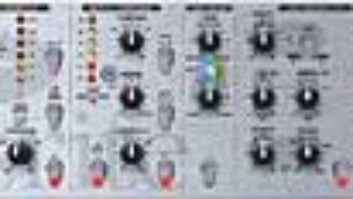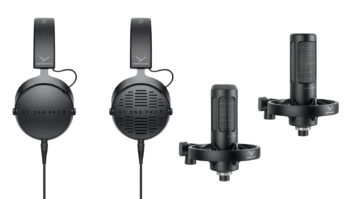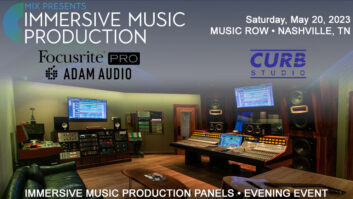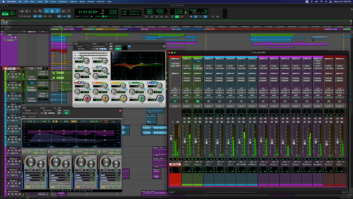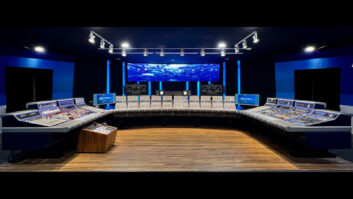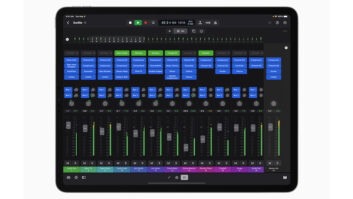

The newest member in Focusrite’s Platinum Series is a 2U channel strip/monitor mixer combination that promises to have everything you’ll need to record, overdub and monitor stereo sources — just add instruments and mics, headphones and speakers, and something good on which to record.
A QUICK OVERVIEW
The TwinTrak has two identical mono channel strips, each comprising a Class-A mic/line/instrument preamp with variable impedance, a very useful mid-scoop filter and a nice-sounding optical compressor. The channels can be linked for stereo or used as two discrete mono paths.
A stereo monitor section includes dual unbalanced send/returns to connect a serial device or other processor. In addition to a built-in headphone amp, the TwinTrak Pro has an output for feeding a dedicated headphone amp. Because the input signal is routed directly through the monitor section, there’s no latency to deal with.
Both ¼-inch line and S/PDIF digital inputs are provided, allowing DAW users to route directly to the unit and back. Focusrite offers an A/D converter option for the TwinTrak but they weren’t included in the review unit.
UNDER THE HOOD
The TwinTrak packs a formidable number of features into its solid-feeling chassis. Starting at the back, features include XLR balanced monitor and main outputs, and parallel -10dBV outputs; line-level inputs separate from the instrument and mic ins on the front panel (with switches on the front panel); TRS inserts and individual compressor sidechain inputs for each channel; and BNC word clock input and DAC out and optional ADC.
The mic preamps provide 60 dB of gain, enough to drive even low-output ribbon mics. There’s a separate six-stage LED meter for each mic preamp, and switches for phantom power, polarity reversal and a highpass filter.
The Air button is an interesting feature, which Focusrite explains as a “wire-wound, inductor-induced” circuit. It adds a pleasing high-frequency boost to the mic inputs and in practice I never turned it off.
The mid-scoop EQ can be swept continuously from 120 Hz to 2 kHz, and it has just two buttons: In and Deep (12 dB of cut instead of 6 dB with the switch out).
Like many optical compressors, the attack varies with the input level, but TwinTrak has switches for slow attack, hard ratio and hard knee. The compression knob is a backward threshold control, and the release becomes automatic in the fully clockwise position.
The comprehensive monitor section includes a mono switch, a balance pot between the two channels and a mute button. The dual analog peak-level reading meters are a nice, rare feature.
As a testament to its quality, the TwinTrak uses a detachable IEC power cord, not a wall wart power supply.
PUT TO THE RECORDING TEST
While the TwinTrak’s circuitry undoubtedly borrows from higher-end Focusrite units’ designs, the Platinum series is the company’s budget line. The TwinTrak ($700, 24/96 A/D option: $250) is priced and designed for use in personal studio rigs — definitely the milieu in which it shines.
I made some quick recordings into Pro Tools through the TwinTrak and two other budget mic preamps. I recorded acoustic guitar, solo cello, key rattling, recorder and spoken word. (The latter is arguably the best test signal for any audio equipment because it’s so obvious when it does or doesn’t sound right.)
The TwinTrak’s mic preamp stacked up quite well next to these budget units — after its impedance control had been adjusted to suit an Audio-Technica 4050. And with the Air circuit engaged, it sounded substantially nicer to my ears.
However, it only works on mics. Sometimes when you compare budget electronics to high-end studio gear, you may notice a loss of, well, air on signals running through the unit. I noticed this whether or not the compressor and filter were switched into the circuit, but, of course, it’s highly dependent on the source; for example, a DI’d electric guitar is unlikely to be a problem.
This is not something that shows up in a spectrum display (I looked at pink noise recordings through the TT and an adjacent channel of my digital mixer in Metric Halo’s SpectraFoo); rather, it’s a matter of how “open” the sound is. There’s a reason Focusrite also makes its high-end Red and ISA lines.
This became apparent when I sneaked the TwinTrak into one of engineer E.T. Thorngren’s sessions for new artist Tenley Bedard. He ran out of a Millennia Media channel strip into the TwinTrak’s line input to use its faster-acting compressor, which is more appropriate for pop vocals.
While the tracks needed a little compensatory air-range shelving EQ, the TwinTrak’s optical compressor performed nicely. Between all of its options, especially the auto-release position, you can make the compressor seen but not heard, or heard but not seen.
Finally, it makes a lot of sense to have a mid-scoop EQ on a recording box. Of course, fully parametric EQ is useful as 99 percent of the time, you just want to get rid of a problem frequency. And, in fact, TwinTrak’s filters proved their mettle on a stereo acoustic guitar recording, getting rid of the typical 180 to 250Hz lumpiness effortlessly and transparently.
CONCLUSION
The TwinTrak Pro is a very well-conceived product with great features, excellent compressor and sound quality unrivalled at this price point.
Focusrite, dist. by Digi-design, 650/731-6300, www.digidesign.com.
Nick Batzdorf is a composer, producer, engineer and writer living in Los Angeles.

• Take a Flash tour of the TwinTrak Pro here. (Flash Player V6 required)
